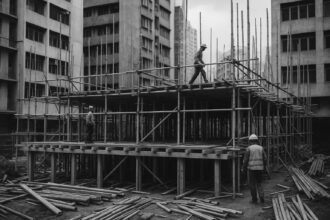Despite new collaboration with the UK Government to boost housing development, Mayor Sadiq Khan admits London faces a crisis comparable to the 2008 financial crash, as rising costs and planning challenges continue to hinder the city’s ability to deliver affordable homes.
Mayor Sadiq Khan has acknowledged that London’s housing crisis remains a formidable challenge, despite ongoing efforts to address it. Recently, Khan welcomed the UK Government’s commitment to collaborate on establishing the City Hall Developer Investment Fund, an initiative intended to unlock further housing developments across the capital. This announcement signals a continuation of efforts to boost the city’s housing supply and tackle affordability issues.
Despite these steps, London’s housing situation remains critical. In late 2024, Khan described the housing market environment as being as difficult as during the 2008 global banking crisis. He highlighted that elevated interest rates, rising costs of construction materials, and the enduring economic impacts of Brexit are exacerbating the difficulties of building new homes. Furthermore, London’s exorbitant house prices—averaging 14 times the typical household income—underscore the severity of the affordability crisis. Khan has been vocal in dispelling misconceptions that blame individual lifestyle choices, such as spending on ‘flat whites or Netflix,’ for the housing shortfall, emphasising instead the structural nature of the problem.
However, Khan’s administration has faced criticism for struggling to meet its ambitious housing targets. Reports from late 2023 indicated that the Mayor was falling short of the pledged annual delivery of 52,000 homes, with actual completions averaging around 36,000 units per year. Various factors contribute to this shortfall, including increased construction costs, interest rate hikes, and bureaucratic hurdles within the planning system. Moreover, critics argue that Khan’s focus on ‘affordable’ housing, while well-intentioned, may be overly restrictive and inadvertently hamper the broader expansion of housing supply. It is also noted that although Khan has significant powers to promote housing development, control over planning permissions remains predominantly with London’s 32 boroughs, which limits the Mayor’s capacity to directly influence building approvals.
In response to the housing and homelessness crises, Khan has unveiled several initiatives aimed at providing immediate relief and long-term solutions. In May 2025, he launched an ambitious plan to end rough sleeping by 2030, which includes refurbishing up to 500 empty homes and creating new support hubs and prevention services. Additionally, Khan has introduced the Council Homes Acquisition Programme (CHAP) to tackle the social housing shortage. This programme seeks to empower local councils to purchase private homes, aiming to add 10,000 affordable homes over the next decade. The urgency of these measures is underscored by the fact that a record 170,000 Londoners, including 83,000 children, are currently housed in temporary accommodations.
Looking back, Khan’s strategy to address London’s housing crisis has always recognised the need for significant government investment and systemic change. As early as 2017, he argued that London required a major and sustained programme to build 66,000 homes annually, with a substantial majority being genuinely affordable. Nevertheless, the persistent gap between targets and delivery reveals the complex interplay of economic, political, and structural factors continuing to impact London’s housing market.
The path to resolving London’s housing crisis remains fraught with challenges, requiring coordinated efforts from City Hall, local councils, and the national government. While new financial tools and programmes offer hope, critics and experts alike caution that only a more flexible, broad-based approach, alongside tackling planning and cost barriers, will enable the capital to meet its ambitious housing goals and truly improve affordability for Londoners.
 Reference Map:
Reference Map:
- Paragraph 1 – [1]
- Paragraph 2 – [2], [1]
- Paragraph 3 – [3], [4], [2]
- Paragraph 4 – [5], [6]
- Paragraph 5 – [7], [3], [4]
Source: Noah Wire Services
Verification / Sources
- https://www.standard.co.uk/news/london/sadiq-khan-housing-claims-shaun-bailey-conservatives-b1241677.html – Please view link – unable to able to access data
- https://www.standard.co.uk/news/london/housebuilding-london-global-banking-crisis-sadiq-khan-affordable-homes-b1193220.html – In November 2024, Mayor Sadiq Khan stated that London’s housebuilding environment was as challenging as during the 2008 global banking crisis. He attributed this to high interest rates, increased construction material costs, and the lasting impact of Brexit. Khan highlighted that the average London house price was 14 times the typical household income, emphasizing the severity of the housing crisis. He criticized those who suggested that personal spending habits, like on ‘flat whites or Netflix,’ were to blame for the housing affordability issue, urging a more realistic understanding of the problem.
- https://www.telegraph.co.uk/business/2023/11/19/sadiq-khan-miss-london-housing-targets/ – In November 2023, reports indicated that Mayor Sadiq Khan was at risk of missing his housing targets due to construction challenges. Despite previous commitments, the delivery of new homes had been below expectations, with an average of about 36,000 homes per year, falling short of the set goal of 52,000 per year. Factors such as rising interest rates, increased construction costs, and planning system issues were cited as contributing to the shortfall. Critics also pointed out that Khan’s housing policies might be overly restrictive, focusing too much on ‘affordable’ housing at the expense of broader housing schemes.
- https://www.telegraph.co.uk/business/2023/11/11/sadiq-khan-failed-london-new-homes-developments/ – An article from November 2023 discussed how Mayor Sadiq Khan had failed to meet London’s housing targets, with average annual home deliveries around 36,000, below the goal of 52,000. The piece highlighted that even doubling the current target might not significantly impact property prices. It also noted that while Khan had various powers to encourage house building, the responsibility for approving developments largely rested with London’s 32 boroughs, limiting his influence. Experts suggested that Khan’s housing policies might be too restrictive, focusing heavily on ‘affordable’ housing and neglecting other housing schemes.
- https://www.london.gov.uk/mayor-launches-rough-sleeping-plan-of-action – In May 2025, Mayor Sadiq Khan launched a new plan of action to end rough sleeping in London by 2030. The initiative focused on prevention and aimed to eliminate the requirement for individuals to be seen sleeping on the streets before accessing support by 2028. The plan included refurbishing up to 500 empty homes, establishing Ending Homelessness Hubs, and creating a new rough sleeping prevention phone line. The Mayor emphasized the need for collaboration with the government, London Councils, and the sector to tackle the crisis effectively.
- https://www.bigissue.com/news/housing/sadiq-khan-social-housing-crisis-right-to-buy/ – In November 2023, Mayor Sadiq Khan announced plans to purchase 10,000 homes from the private market to address London’s social housing crisis. The Council Homes Acquisition Programme (CHAP) aimed to provide councils with the funds to buy homes from homeowners and private landlords, increasing the number of affordable homes over the next decade. This move was in response to the record 170,000 Londoners, including 83,000 children, living in temporary accommodation, highlighting the urgency of the housing situation.
- https://www.theguardian.com/commentisfree/2017/oct/27/were-starting-to-fix-londons-housing-crisis-but-the-government-has-to-help – In October 2017, Mayor Sadiq Khan addressed London’s housing crisis, emphasizing the need for a major and sustained programme of government investment in new affordable housing. He highlighted that the private sector alone could not deliver the scale of homebuilding required, stating that systemic government failure had led to a significant backlog. Khan argued that to meet the demand, London needed to build 66,000 homes a year, with 65% of them being genuinely affordable, nearly double the current construction rate.
Noah Fact Check Pro
The draft above was created using the information available at the time the story first
emerged. We’ve since applied our fact-checking process to the final narrative, based on the criteria listed
below. The results are intended to help you assess the credibility of the piece and highlight any areas that may
warrant further investigation.
Freshness check
Score: 7
Notes: The report includes recent developments, such as the City Hall Developer Investment Fund and the £100m Housing Kickstart Fund. However, it also references outdated information like the 2017 housing strategy. The mention of a record 170,000 Londoners in temporary accommodation aligns with late 2024 data. The mixture of updated and older information justifies the freshness score, but the outdated strategy references should be flagged.
Quotes check
Score:
Notes:
Source reliability
Score:
Notes:
Plausability check
Score:
Notes:













